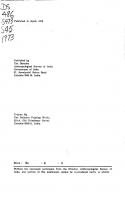Cultural profile of Shillong
Seminar on the Cultural Profile of Shillong (1973 : Shillong, India)
387 23 48MB
English Pages [201] Year 1979
Recommend Papers

- Author / Uploaded
- B. B. Goswami
File loading please wait...
Citation preview
CULTURAL PROFILE OF SHILLONG
Edited by B. B. GOSWAMI
Foreword by S. C. SINHA
I
'
ANTHROPOLOGICAL SURVEY OF INDIA INDIAN MUSEUM
27 Jawaharlal Ne.hru Road Calcutta• 7000 16
Digitized by
Google
Original from
UNIVERSITY OF MICHIGAN
--- ---- ----. , 473
-
Published jn April, 1979
I
. .
Published bJI
The Director Anthropological Survey of India, Government of India. 27, Jawaharlal Nehru Road Calcutta-7000 16, India.
Printed By
The Reliance Printing Works, 219-A, Old Chinabazar Street, Calcutta-7000 01, India.
Price :
Rs.
:£
: $
Without the expressed per1n.ission from the Director, Anthropological Survey of India, any portion of this publication cannot be re-produced partly or wholly.
Digitized by
Google
Original from
UNIVERSITY OF MICHIGAN
•
-CONTENTS .
- .
•
•
Contributors
l
•
••
Foreword
11
Introduction
V
..
1
Inaugural Address
•
•
First Session
SHILLONG AS AN _URBAN CENTRE
1.
.,
The Study of Community-wise Distributio11 & the Growth of Population in Shillong: K. D. Saha 4
'
'
.
,
...
.
Educational Profile of Shillong : N. Das Gupta
32
Impact of Christianity on the People of Shillong . : E. H. f akyntein
39
Shillong as -an Administrative Centre :· B. Datta ·Ray
45
Politics in Shillong : A Study in Inter-ethnic Conflict & Co-operation : S. K. Chaube
56
Second Session
•
CULTURAL CORE & DIVERSITIES
2.
.
'
.
Shillong : A Geographic Analysis of Internal Variations : J. P. Singh 69 •
A Profile of the Shillong Municipal Board : V. Venkata Rao
86
The Transition from the Village to the Town : T. Cajee -
96
•
-
Land System in Shillong : R. T. Rymbai
104
Students of Shillong : A Profile : R. B. Vieyra
109 •
Digitized by
Google
Original from
UNIVERSITY OF MICHIGAN
ii
Sweepers of Shillong : Jayanta Sarkar
116
Women Traders of Shillong : N. Saha C. K. Shyam & S. K. Muk~erjee
132
Seng Khasi : A. S. Khongphai
141 .
The Bat a Bazar ( lewduh ) of Shillong : Emlyn M. Roy
148
1
I
Third Session 3.
EMERGING CULTURAL FEATURES OF SHILLONG
Contribution of Shillong towards Khasi Literature : Tngensi Rynjah
154
Archery in Khasi Hills : R. Jobrenson Khongwir
160
Pop Singers of Shillong : Martin Naryan Majaw
165
CONCLUDING REMARKS
What We Have Learnt from this Seminar : S. C. Sinha
179
Name of Participants
184
Digitized by
Google
Original from
UNIVERSITY OF MICHIGAN
CONTRIBUTORS Shri T. Cajee, I.A.S., Secretary, Government of Meghalaya, Shillong. Dr. S. K. Chaube, Fellow, Centre for Studies in Social Science, Calcutta. Shri N. Dasgupta, Lecturer in P. G. T. College, Shillong. Dr. B. Dutta Roy, Head of the Department of Political Science, St. Edmund's College, Shillong . .
Shri A . S. Khongphai, President, Seng Khasi, Shillong. Shri R. J. Khongwir, Lecturer in Khasi, St. Anthony's College. Shillong. Prof. M. N. Majaw, M.L.A., Meghalaya, Shillong. Shri E. H. Pakyntein, I.A.S. (Retd). Member, Adviser Planning Board, Meghalaya, Shillong. Dr. V. Venkata Rao. Emiritus Professor, Department of Political Science, University of Gauhati, Gauhati. Shri E. M. Roy. Mylliem State Office, Shillong. Shri R.. T. Rymhai, I. A. S. (Retd). Chairman, Land Reforms Commission, Meghalaya, Shillong . •
Shri T. Rynjah, Lecturer in Khasi. Sankardev College, Shillong. Shri K. D. Saha, Anthropological Survey of India, Shillong Dr. J. K. Sankar. Anthropological Survey of India. Shillong. Shri J.P. Singh, Lecturer in Geography, St. Edmund's College, Shillong. Sarvashri N. Saha, C. K. Shyam & S. K. Mukherjee, Anthropological Survey of India, Shillong. Brother R. B. Vieyra, Principal, St. Edmund's College, Shillong. Digitized by
Google
Original from
UNIVERSITY OF MICHIGAN
FOREWORD •
During 1962 to 1964 the late Professor Nir~al Kumar Bose, the then Director, Anthropological Survey of India, organised a socio-cultural survey of the city of Calcutta. The results of the survey were published in the form of a book, Calcutta, a Soeial Survey (/968) and an important article Calcutta, a Premature Metropolis ( 1965). Professor Bose was mainly interested in finding out to what extent the people of Calcutta continued to remain socially segregated in terms. of language and religion in location, occupation and voluntary associations. This pioneering venture in urban anthropology encouraged us to look into the complexities of cultural life in Calcutta in a seminar jointly organised by the Anthropological Survey of India and the Indian Anthropological Society during January 22-23, 1970. The distinctive feature ◊f the seminar was to involve academicians and practitioners from discip.. lines, such as, linguistics, social psychology, psychiatry, history, natural science,, literature and other creative artistic fields iri a dialogue with anthropologists in defining the cultural profile of the city. The seminar was organised around three major themes : ••A City of Cultural Pluralism and the Bengali Core'', ''A City of Grinding Poverty, Economic Disparity and Social Disorganization'• and ••A City of Creativity and Frustration''. The proceedings of the seminar was published in 1972. . The. above model, with some modification, was utilized in drawing out the Social Profile of Mysore City in a seminar organised in · December, 1970 by Dr. Promode K. Misra, qfficer-in-Charge of the South India Station of the .l\nthropological Survey of India . A former member of this Survey, Dr. Baidyanath Saraswati, conducted a similar seminar on . •·Social and Cultural Profile of Kashi'' at Varanasi during January 22-25, 1973 on behalf of Manab Vijnan Mandir: Bose Memorial Foundation. •
Digitized by
Google
Original from
UNIVERSITY OF MICHIGAN
l
•
•
I
,.,
111
I
From the above three seminars we .can .form an idea how the three cities socially and culturally handle the problems of diversity in terms of primordial groups and socio-economic classes. We can also compare the distinct cultural and organizational accents in the pursuit of excellence in three cities. In none of the above three cities, however, Scheduled Tribes form a significant constituent. We, therefo·r e, decided that members of that Northeast India Station of this Survey at Shill·o ng should initiate a seminar on the cultural profile of the urban milieu of Shillong where tribes of Northeast India formed a very important element; Shillong has for a long time been an important arena for nurturing the process of cultural and political moderr1ization of the tribes of Northeast India, notabley the Khasi. Since April, 1970Shillong has become the capital of the newly formed state of Meghalaya, where the tribal elites belonging to the Khasi, Garo and~the Jayanti tribes are vigorously engaged in carving out a modern destiny while resolving encounters with the massive Bengali population in the city. '
'
•
~
In the seminar on cultural profile of Shillong organised by Shri B. B. Goswami and his associates of the Northeast India Station of the Anthropological Survey of India during September 28-29, 1973, the majority of the participants were not anthropologists. They represented a wide range of disciplines like political science. human geography, literature, music, administration and so on. Four members of the Anthropological ,Survey of India .c ontributed papers on the basis of field research. It is indeed a matter of great satisfaction to us that c·aptain Williamson A. Sangma, Chief Minister of Meghalaya State has taken great interest in our modest endeavour. We are grateful to him for inaugurating the seminar. We are also very thankful to Dr. C. Devanesan, Vice-Chancellor, Northeastern Hill University for presiding over the inaugural function. I have recorded my detailed .
Digitized by
Google
Original from
UNIVERSITY OF MICHIGAN
' . lV
responses to the various papers pres~nted in the seminar in my concluding remarks appended to this volume. I hope that the proceedings of the seminar which have been carefully edited by Shri B. B. Goswami will be read with interest by social scientists, administrators and leaders of public opinion interested in the problems of Northeastem Region. This seminar also encourages me to plan a series of seminars on the culture profile of the major urban centres in the states and Union Territories in the north eastern hill region. We expect that a quick succession of such seminars, based on proper preparation, will bring into focus some of the urgent socio-cultural problems of modernization in the north eastern hill regions of India. They will also provide very useful forums of critical and creative discourse between social scientists and the growing· members of tribal intelligentsia in this region. SURAJIT SINHA Director Anthropological Survey of India
•
Digitized by
Google
Original from
UNIVERSITY OF MICHIGAN
1NTR0DUCTION The Seminar on the Cultural Profile of Shillong is the 4th Seminar in urban anthropology which was held in the State Central Library Seminar Hall on the 28th and 29th and September, 1973. The earlier Seminars on Cultural Profile were held at Calcutta, Mysore and Varanasi where the Anthropological Survey of India was involved either as organiser or collaborator. The idea for organising these Seminars was initiated by Dr. S. C. Sinha, Director, Anthropological Survey of India, who during the Seminar on Calcutta stated that this ••effort is to make the social scientists, in general, and anthropologists in particular, aware about some of the problems involved in systematic understanding of the complex social and cultural reality of this city''. Dr. Sinha guided me closely in the organisation and supervision of the Seminar. He also participated very actively during the various sessions of the ·Seminar. ~
i
The Seminar was inaugurated on the 28th September, 1973 by Capt. W. A. Sangma, Chief Minister of Meghalaya. Dr. Chandran D. S. Devanesan, Vice-Chanceller of the North Eastern Hill University, Shillong, kindly presided over the function. To draw the prefile of Shillong, the papers were grouped under three broad headings, viz., Shillong as an Urban Centre, Cultural Core and Diversities of Shillong and Emerging Cultural Features of Shillong. The concluding · speech was delivered by Dr. S. C. Sinha. He in his speech succinctly dealt with the main thursts of the discussions held in various sessions.
· - To get involved in such a Seminar in Shillong was a
Digitize~ by
Google
Original from
UNIVERSITY OF MICHIGAN
Vl'
rewarding experience for me. Initially, I was discouraged by some about the utility to organise such a Seminar. But in course of time, I observed that there were many who were ready to participate in such an intellectual encounter . . In the seminar, altogether 17 papers were pre$ented. They were grouped in 3 sessions for discussions, which were presided by Shri D. K. Bhattacharjee, Secretary, North Eastern Council, Shri R. S. Lyng doh. Speaker, Meghalaya Legislative As~embly and· Dr. S. C. Sinha, Director, Anthropological Survey of India, Calcutta. Among the participant in the seminar the member of the Anthropological Survey of India formed a minority. It was because of two main reasons. Firstly, with our limited technical personnel in the Station it was not possible to extend rigorous anthoropological enquiry on the varied facets of cultural life of a complex urban milieu like Shillong. Secondly, we felt, in the light of the earlier excersises in Calcutta., Mysore and Varanasi that like growing field of urban anthropology will have to receive successor from points of view of other disciplines as also of endogamous urban intellegentsia in general. We expect that this excercise will trigger off further stimulating discussions in formal and informal manner among the . academicians and infelligentsia of the town. I h·ave much pleasure in recording that the entire staff of this station took an active interest in the · Seminar. In this matter Sarvashri S. H. Ahmad, S. H." M. Rizvi, M. M. Das, B. B. Das, S. K. Ghosh, C. K. Shyam, ·N. Saha and S. K. Mukherjee rendered all possible help. The typing work was mainly done by Shri K. Das and Mrs. D. Wahlang. _ ~I .requeste.d- the . authors to revise their papers, if neces•
Digitized by
Google
Original from
UNIVERSITY OF MICHIGAN
,
sary, in the light of the discussions held, though our approach was to honour the perspectives of the authors and to make as little change as possible.
B. B. GOSWAMI Anthropological Survey of India, North East India Station, Shillong .
•
Digitized by
Google
Original from
UNIVERSITY OF MICHIGAN
•
Digitized by
Google
Original from
UNIVERSITY OF MICHIGAN
lnaupral Address
•
Capt. Williamson A. $an1m•, Chief Minister, Meghaloya.
Friends, •
It gives me great pleasure to be here this morning and to associate myself with this Seminar on the Cultural Pl'.ofil~ of • Shillong. The Anthropological Survey of India deserves to be congratulated for organising a Seminar of this kind in Shillong. I understand that the Anthropological Survey has been responsible for holding similar Seminars in Calcutta, Banares and other places also. The platitude about ''Unity in Diversity'' is often repeated in our country. India is a land of many religions, languages and cultural traditions. But what is less often noticed is the fact that most of us do not have even the remotest idea of the culture and traditions of our fellow countrymen outside our · own home States. In fact, many of us are far better inform~d o·r the history and culture of foreign countries than of bur own co_untry. In other words, ·there is a genuine need for understanding our own country better. We have already comp1eted . . a quarter century as a free nation. During this period, there has been a massive eJtpansion in the means of transport and communication in our country and a great many people are travelling from one part of the country to another in connection with ·t heir work. But still the amount of ignorance even .among the educated classes when it comes to some part of the country other than their own home States is staggering. When it comes- 'to North Eastern India, facts are even less familiar to our fellow countrymen elsewhere in the country. I hav~ myself had a number of occasions to come across the . most astonishing ignoranc~ in some people about the geo.
Digitized by
Google
Original from
UNIVERSITY OE
' GAN
2
1
CULTURAL 1•Rorli.E or
Slill.i.oNG
graphy, linguistic and ethnic groups, and administrative units of the North Eastern Region. I am referring to· the ignorance · of the educated, the cultured and the elite of our political and admi:11is~ative classes. One could very well imagine the state of the common man's understanding of the rest of the country. Jawaharlal Nehru spoke of his 'Discovery' of India. Practically. everyone of us has to make an effort to discover thi~ country. Unfortunately, this is not a thing which comes naturally or taken care of in the ordinary course of growing up. Our newspapers and mass media have also not been able to create a balanced and dispassionate understanding of the facts and problems of every part of the country among our people. Perhaps this is in the very nature of the wo_rl
Its official recognition was due to the fact that being much less rainy than Cherrapunjee, a military sanatorium was established here in the fifties of the last century. Its selection as the district headquarters and later as the headquarters
Digitized by
Google
Original from
UNIVERSITY OF MICHIGAN
.....
48
CULTURAL PROl'JJ,E OF :;Att,t.oNG
of the Chief Commissionership of Assam and still later as the capital of the province of Assam has a history. After the quelling of the Khasi resistance to the British intrusion in 1833, a Political officer was posted at Nongkhlaw, the centre of Khasi nationalism. Soon the post was shifted to Cherrapunjee. It c_o ntinued there till 186Z-63, the date of Jaintia rising. Col. Hopkinsons, the then Commissioner of Assam, pointed out at that time that Shillong being more strategically situated would be a superior location for the headquarters of the Commission. The Committee appointed in 1862 to select the district headquarters for these hills recommended a site on the plateau of the Shillong Peak higher by about 900 ft. than the present location of Iewduh. Before Col. Hopkinson it was David Scott, the first British Commissioner of Assam who had his headquarters at Gauhati in 1826, who .first pointed out the political, military and administrative advantages of the Khasi and Jaintia Hills. Of course, his heart was set for Nongkhlaw. It was left to Henry llopkinson who succeeded Francis Jenkins as Commissioner in 1001 to take up the matter seriously and press for the establishment of the present headquarters of Assam at Shillong. According to him Gauhati and other places in the Brahmaputra Valley were not as advantageous as Shillong. The Officers of the Deputy Commissioner were transferred to Shillong in 1864-66. By that time the headquarters of the Frontier troops and the Superintending Engineer and the establishment of the Deputy Inspector General of Police were also shifted here. At that time, Shillong was the best possible place to watch over and control the Jaintia Hills which had broken into rebellion for the second time in 1862. Col, Hopkinson himself lived in Shillong for a part of the year since 1866. But the Board of Revenue of the Bengal Government was strongly against it on the ground that Shillong was inaccessible to the people of the Assam Valley.
Digitized by
Google
Original from
UNIVERSITY OF MICHIGAN
◄
SllILLONG
AS AN
ADMINISTRATIVE
CENTRt
The controversy continued till 1874 when Col. Keatinge, the First Chief Commissioner of Assam with his provisional headquarters at Gauhati, was given full discretion in the selection of a permanent location and he selected Shillong. The grounds for his preference were :
',I
.
(i) Shillong was strategically in the centre of the Chief Commissionership. (ii) Road building was easier in Shillong than in the plains. (iii) · It was well connected with other parts of the country with one road leading down to Gauhati, another via Cherrapunjee . to East Bengal, and another to the eastern parts of Assam. (iv) By the Cherrapunjee Road with the then existing system of communication it was nearer to Calcutta and easier of approach. (v) The scope of expansion was larger here than at Gauhati. (vi) Building materials were cheaper and more readily and easily available in Shillong. (vii) The climate was more suitable to the Europeans who would be in charge of the Administration. (viii) The establishment of the office of the Chief Commissioner would initially cost very little as the already existing cutchery building and barracks and Col. Biver's bungalow could be made immediately available for accommodation.
•1
> I f
•
Accordingly, the capital of Assam was shifted on March 20, 1814 not to Shillong-but to the Valley of Iewduh-below Shillong. In the early papers it is called valley of Iewduh, but gradually the present name related to a popular local 7 Digitized by
Google
Original from
UNIVERSITY OF MICHIGAN
.
.
CULTURAL
PROFILE
OF
SHILWNG
myth·. and 'associated· with the highest hill feature replaced
it; Since then Shillong has remained the capital of Assam . -except for a brief period of about a year in 1911-12 during ,ha days of Eastern Bengal and Assam. It is clear from the history of Shillong that it is entirely a ;Creation of the British Administration and its growth has always . been closely related to the growth of the Administration. The first settlement was that of the administrative personnel round which accrued. in course of time, a trading community and civic services which catered to the need of the core population. This core comprised people inducted from outside for ministerial services from Bengal and for what it is now known grade IV from Bihar, Nepal, etc. 'rhe top level comprised European Officers. Its total number would have been at the most 500. The local people were not much interested in getting in service with the Administration. The newly born headquarters was given the status of a station, ,tJ:ie _lowest urban unit, though the original intention was to . . treat it as a rural area and to grade it a union. )
_ ._. As the Government of India was all along guided .by the principle of economy in the development of the administration of the new Chief Commissionership, the development . of _,.,he administrative structure and establishment suffered retarded growth owing to inadequacy of funds. Still necessity ~ork~d and the administrative establishment expanded t}:lough -. .slowly and with its expansion the town also grew. In 1878, i,., ya~ only 106 ho~eholds ; traders from Cherrapunjee were p~rsuaded to settl_e here and so the present _ Police Bazar -, came into being. Ba rabazar long remained outside its orbit and remained for long a place of local and rural trade. The" -'oldest settlements were around the ancient village of ·Labatt and Jail Road. In these the Bengali element predotnln'cites-lhey being the earliest outsiders inducted. The ~l&;st element in the Police Bazar area is the Bengali Muslim ,
•
{
•
"'
I
•
•
•
•
• Digitized by
Google
Original from
UNIVERSITY OF MICHIGAN
SHILLONG
AS
AN
ADMINISTRATIVE
CENTRE
.
61 ,
traders settled from Cherrapunjee .and East Bengal... · Th~ Marwari and other traders were late comers . . Until indepe~dence was achieved and s'ometirri-e . after that .Shillong .retained its character of small but . importa"n t administrative outpost along with that of a less freqllented and so· quiet arid lovely hill-station. It was sheltered· fron\ the movements that agitated the plains and the · roads . to'·· t · t . being easily controllable with checks and gates any political unrest could • be stopped from penetrating h·e re·. Indeed . popular leaders did rise their voice against the location ,be'yond the reach of the common man in the plains, ye1 they retained Shillong as the capital after independence,·: btit decided to change its restricted character by a process·•or . . induction, introducing more of elen,ents of the state·.·· Accor~ dingly, large areas around the nucleus available after:.the partition : of the country and the departure of a large numbet of British owners, were procured where Government etri} ployees .from the plains were given lands en lone . -to be recouped in easy instalments. This led to the rapid growtq ' . of the ''Shillong Urban Agglomeration'' because with the. ' . sudden growth of the administrative structure to deal. with the _new com~itments of the welfare state, housing pro~lems h~d grown acute and the o_w ners of houses could earn good inc

![Volume Profile, Market Profile, Order Flow: Next Generation of Daytrading [1 ed.]
9798572101812](https://ebin.pub/img/200x200/volume-profile-market-profile-order-flow-next-generation-of-daytrading-1nbsped-9798572101812.jpg)







